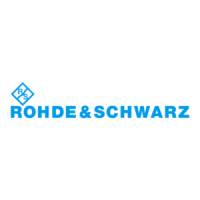Concepts and features
R&S
®
ZNA
123User Manual 1178.6462.02 ─ 20
Meaning of 2-port S-parameters
The four 2-port S-parameters can be interpreted as follows:
●
S
11
is the reflection coefficient of DUT port 1, i.e. the ratio between outgoing wave
b
1
and incident wave a
1
in a forward measurement with matched DUT port 2:
S
11
= b
1
/ a
1
, if |a
1
| > 0 and a
2
= 0
●
S
21
is the forward transmission coefficient, defined as the ratio between outgoing
wave b
2
and incident wave a
1
in a forward measurement with matched DUT port 2:
S
21
= b
2
/ a
1
, if |a
1
| > 0 and a
2
= 0
●
S
12
is the reverse transmission coefficient, defined as the ratio between outgoing
wave b
1
and incident wave a
2
in a forward measurement with matched DUT port 1:
S
12
= b
1
/ a
2
, if |a
2
| > 0 and a
1
= 0
●
S
22
is the reflection coefficient of port 2, i.e. the ratio between outgoing wave b
2
and
incident wave a
2
in a forward measurement with matched DUT port 1:
S
22
= b
2
/ a
2
, if |a
2
| > 0 and a
1
= 0
Meaning of squared amplitudes
The squared amplitudes of the incident and outgoing waves and of the matrix elements
have a simple meaning:
Table 4-3: Squared S-parameters
|a
i
|
2
Available incident power (= the power provided by a generator with
a source impedance equal to the reference impedance Z
0
) at DUT
port i=1,2
|b
i
|
2
Reflected power at DUT port i=1,2
10 log|S
ii
|
2
= 20 log|S
ii
|
Reflection loss at DUT port i=1,2
10 log|S
21
|
2
= 20 log|S
21
|
Insertion loss of forward transmission
10 log|S
12
|
2
= 20 log|S
12
|
Insertion loss of reverse transmission
4.3.1.1 Multiport S-parameters
The multiport S-parameters extend the standard 2-port S-parameters to a larger num-
ber of incident and outgoing waves. For a 4-port DUT,
a
a
a
a
SSSS
SSSS
SSSS
SSSS
b
b
b
b
4
3
2
1
44434241
34333231
24232221
14131211
4
3
2
1
where again a
i
(i = 1 to 4) denote the incident, b
i
(i = 1 to 4) denote the outgoing waves,
and the S-parameters are expressed as S
ij
(i,j = 1 to 4).
Measurement results

